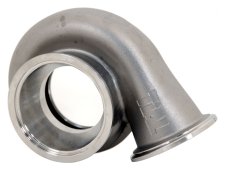Warpspeed
Solar Wizard
I am a city suburban dweller, so no hydro for me...
Anyhow, we are all familiar with large majestically turning water wheels, and those small frantically spinning Pelton wheels, but there is not really much available to us in between those two extremes.
Larger commercial hydro schemes that do not have a very large head of water, invariably use some form of Francis turbine.
These are particularly efficient, because water in the snail shaped volute forms into a free vortex, which powers ALL of the blades ALL of the time.
The result is MASSIVE torque that is just not available to a Pelton wheel, or water wheel, where only one bucket or one blade is being powered at any one instant.
There is a lot of very complex curved geometry inside a Francis turbine that would normally put it way out of the reach of home brew fabrication.
Over the last few decades, turbochargers have now reached a very high stage of development, especially the exhaust turbine side, which is of most interest to us here.
These spin at fantastically high rpm and generate many shaft horsepower, driven by only hot air !
To make these as efficient as they now are, requires some very complex design and precision both in the snail shaped volute, and the curved turbine blades.
The operating principle is EXACTLY that of the larger Francis turbine, with all the exact same geometry, but obviously much smaller.
Not only that, exhaust gasses are extremely corrosive, so the turbine wheel and shaft are made of a very high grade of very hard stainless steel, which can never corrode or be abraded when used as a water turbine.
Water is about 784 times as dense as air, and a small turbocharger turbine would turn much more slowly and generate vastly more torque than with the exhaust gas flow it was originally designed for. http://www.theweatherprediction.com/habyhints/216/
Turbochargers also come in a wide range of sizes, and for each size, several different turbine housings (nozzle size) are available, where you could adjust turbine rpm and water flow within a certain limited range to suit the application.
Turbochargers can have either sleeve bearings or ball bearings, and are usually pressure fed from the engine oil supply.
Our water turbine will only be turning relatively slowly, and we could just pack it with grease.
The grease to use would be boat trailer bearing grease which happily does not break down when continually completely immersed in even salt water.
If I had the opportunity, I would really like to get my hands on an old turbo from a large truck.
Car sized turbos are all pretty small, for the type of Mini Hydro I am thinking of.
Maybe this will spur someone into trying out this idea.
Anyhow, we are all familiar with large majestically turning water wheels, and those small frantically spinning Pelton wheels, but there is not really much available to us in between those two extremes.
Larger commercial hydro schemes that do not have a very large head of water, invariably use some form of Francis turbine.
These are particularly efficient, because water in the snail shaped volute forms into a free vortex, which powers ALL of the blades ALL of the time.
The result is MASSIVE torque that is just not available to a Pelton wheel, or water wheel, where only one bucket or one blade is being powered at any one instant.
There is a lot of very complex curved geometry inside a Francis turbine that would normally put it way out of the reach of home brew fabrication.
Over the last few decades, turbochargers have now reached a very high stage of development, especially the exhaust turbine side, which is of most interest to us here.
These spin at fantastically high rpm and generate many shaft horsepower, driven by only hot air !
To make these as efficient as they now are, requires some very complex design and precision both in the snail shaped volute, and the curved turbine blades.
The operating principle is EXACTLY that of the larger Francis turbine, with all the exact same geometry, but obviously much smaller.
Not only that, exhaust gasses are extremely corrosive, so the turbine wheel and shaft are made of a very high grade of very hard stainless steel, which can never corrode or be abraded when used as a water turbine.
Water is about 784 times as dense as air, and a small turbocharger turbine would turn much more slowly and generate vastly more torque than with the exhaust gas flow it was originally designed for. http://www.theweatherprediction.com/habyhints/216/
Turbochargers also come in a wide range of sizes, and for each size, several different turbine housings (nozzle size) are available, where you could adjust turbine rpm and water flow within a certain limited range to suit the application.
Turbochargers can have either sleeve bearings or ball bearings, and are usually pressure fed from the engine oil supply.
Our water turbine will only be turning relatively slowly, and we could just pack it with grease.
The grease to use would be boat trailer bearing grease which happily does not break down when continually completely immersed in even salt water.
If I had the opportunity, I would really like to get my hands on an old turbo from a large truck.
Car sized turbos are all pretty small, for the type of Mini Hydro I am thinking of.
Maybe this will spur someone into trying out this idea.
Attachments
Last edited:





